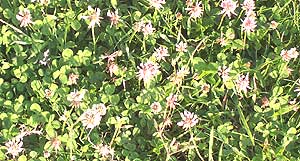
Laminitis in Horses & Ponies - Causes, Symptoms, Treatment
Equine Laminitis is a painful disease of a horse of pony's foot. Laminitis is caused by circulatory changes in the hoof causing inflammation in the sensitive laminae of the feet.
Laminitis is also known as "Founder" and causes severe lameness.
Prevention and treatment of laminitis in horses is possible with special care.
Laminitis mainly affects both of the front feet.
In an acute case the horse or pony resists moving, tends to bear all possible weight on the unaffected hind feet, and will appear to be slightly "sitting" with his front legs stretched forward.
In severe cases of laminitis the horse or pony may spend a lot of time lying flat out on his side.
In a healthy foot the laminae are the membranes that hold pedal bone in place inside the foot.
Unless the condition is diagnosed and the laminitis treated immediately the sensitive laminae begin to die and the attachment of the pedal bone is weakened.
PEDAL BONE ROTATION
Then the upward pull of the tendons in the leg can cause the pedal bone to rotate or sink within the horse's hoof.
In acute equine laminitis the laminae can be so damaged that the pedal bone penetrates right through the sole of the horse's foot in front of the frog and the horse has to be put down.
As the pedal bone rotates in the hoof it compresses the blood supply to the coronet - this slows down the rate of hoof growth.
LAMINITIC HOOF RINGS
This results in the characteristic laminitic hoof rings which are wider at the heel than the toe. - producing a hoof with high heels and a long upward curving toe.
In chronic cases of equine laminitis there is less movement of the pedal bone, but the inflammation causes extra growth of horny tissue between the outer hoof wall and the sensitive laminae.
As a result the "white line" of the hoof is widened and becomes an area of weakness prone to seedy toe, white line disease and abscesses.
A good equine horse insurance policy will cover the cost of treating laminitis.
|
|
HORSE CARE ADVICE AND EQUESTRIAN ARTICLES
Benefits dangers feeding Garlic to horses | Riding a Napping Horse | Equine Devil's Claw | Horse Feed Balancers | Homeopathic Ringbone Treatments for Horse | Horse worming programs | Maintaining Veteran horses | Glucosamine horses | Magnotherapy | Equine nosebleeds | Horse Cracked Heels Winter | Selenium Horses | Choke | Angleberry warts | Treating a horse that has Redworm | Horse with Mud Fever | Removing Bot Eggs | Cambridge Horse feed | Horse bedding | Pony Pelham Bit | Horse feed supplies - Norfolk | Equine Bone Spavins | Horse Dentistry | Horse Hoof Care | Aubiose | Symptoms of Horse with Colic | Feeding Carrots | What to feed a horse suffering from Liver disease | Herbs that Help to Calm a Horse | Sticky Stifle | | Moody Mare Supplement | B vitamins horses | Biotin Horse Feed Supplements | Haylage | Probiotics | Diarrhea in horses | Strangles Symptoms in Horses | Arthritis Supplements for Horses | Arnica for horses |
